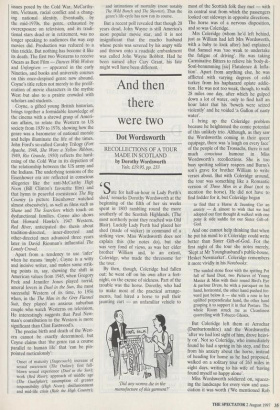Death of the gunfighter
Philip French
THE CROWDED PRAIRIE: AMERICAN NATIONAL IDENTITY IN THE HOLLYWOOD WESTERN by Michael Coyne I. B. Tauris, £25, pp. 239 The only movie most people can name earlier than D.W. Griffith's 1915 Birth of a Nation is The Great Train Robbery of 1903. Drawing on Victorian melodrama and the dime novel, its worldwide success created a distinctive popular form, the Western, which was to play a significant role in American culture and politics over the next century. Arthur Schlesinger Jr. called it `America's distinctive contribution to the film'; his fellow liberal intellectual, Dwight Macdonald, denounced it as 'one of the most vapid and infantile forms of art ever conceived by the brain of a Hollywood movie producer'. The Great Train Robbery was shot in New Jersey, just across the Hudson from New York City. Ten years later, tyro New York film-maker Cecil B. DeMille journeyed further West, and find- ing Arizona snowbound he continued on to Los Angeles to make his cinematic debut directing the Western The Squawman in the then unknown suburb of Hollywood. Over the next quarter century there was an abundance of Westerns (and the trade papers published an annual list of the top Western stars) but most of them were cheap B-features and only a small handful were major productions from the leading studios. This changed in 1939 when John Ford, a world-class director who had begun his career churning out one-reel horse operas in the silent era, directed his first sound Western, Stagecoach. Immediately recognised as a classic, it made a star of John Wayne, who had spent a decade in low-budget movies on poverty row, and ini- tiated what Michael Coyne rightly regards as the golden age of the Western. This last- ed until the bicentennial year of 1976 when the cancer-stricken Wayne bowed out play- ing a cancer-stricken gunslinger in The Shootist.
The death knell for the Western has been rung at frequent intervals since the 1940s, but far from dying it flourished as never before as a way of confronting, in a historically simplified context, the complex issues posed by the Cold War, McCarthy- ism, Vietnam, racial conflict and a chang- ing national identity. Eventually, by the mid-1970s, the genre, exhausted by overexposure on television, and its tradi- tional stars dead or in retirement, was no longer speaking to audiences the way cop movies did. Production was reduced to a thin trickle. But nothing has become it like its death. The first two Westerns to receive Oscars as Best Film — Dances With Wolves and Unforgiven — appeared in the early Nineties, and books and university courses on this once-despised genre now abound. Coyne's title refers not merely to the prolif- eration of movie characters in the mythic West but also to a prairie crowded with scholars and students.
Coyne, a gifted young British historian, brings together a formidable knowledge of the cinema with a shrewd grasp of Ameri- can affairs, to relate the Western to US society from 1939 to 1976, showing how the genre was a barometer of national morale and helps illuminate the life of the times. John Ford's so-called Cavalry Trilogy (Fort Apache, 1948, She Wore a Yellow Ribbon, 1949, Rio Grande, 1950) reflects the hard- ening of the Cold War in its depiction of the relationship between the US army and the Indians. The underlying tensions of the Eisenhower era are reflected in conscious allegories like the anti-McCarthy High Noon (Bill Clinton's favourite film) and that hymn to peaceful coexistence The Big Country (a picture Eisenhower watched almost obsessively), as well as films such as Shane and The Searchers which touch on dysfunctional families. Coyne also shows that Howard Hawks's 1947 Western, Red River, anticipated the thesis about tradition-directed, inner-directed and other-directed men advanced three years later in David Riesman's influential The Lonely Crowd. Apart from a tendency to use 'infer' when he means 'imply', Coyne is a witty and incisive writer, and makes some strik- ing points in, say, showing the shift in American values from 1945, when Gregory Peck and Jennifer Jones played torrid, amoral lovers in Duel in the Sun, the most successful Western of its time, to 1956 when, in the The Man in the Grey Flannel Suit, they played an anxious suburban couple who watch Westerns on television. He interestingly suggests that Paul New- man's contribution to the Western is more significant than Clint Eastwood's. The precise birth and death of the West- ern cannot be exactly determined, but Coyne claims that 'the genre ran a course parallel to human life' that 'can be pin- pointed meticulously':
Onset of maturity (Stagecoach); increase of sexual awareness (The Outlaw); first full- blown sexual experience (Duel in the Sun); work (Red River); approach of middle age (The Gunfighter); assumption of greater responsibility (High Noon); disillusionment and mid-life crisis (Ride the High Country); and intimations of mortality (most notably The Wild Bunch and The Shootist). Thus the genre's life-cycle has now run its course.
But a recent poll revealed that though 20 years dead, John Wayne is still America's most popular movie star, and it is not insignificant that the macho husband whose penis was severed by his angry wife and thrown onto a roadside embankment was called John Wayne Bobbitt. Had he been named after Cary Grant, his fate might well have been different.



























































 Previous page
Previous page